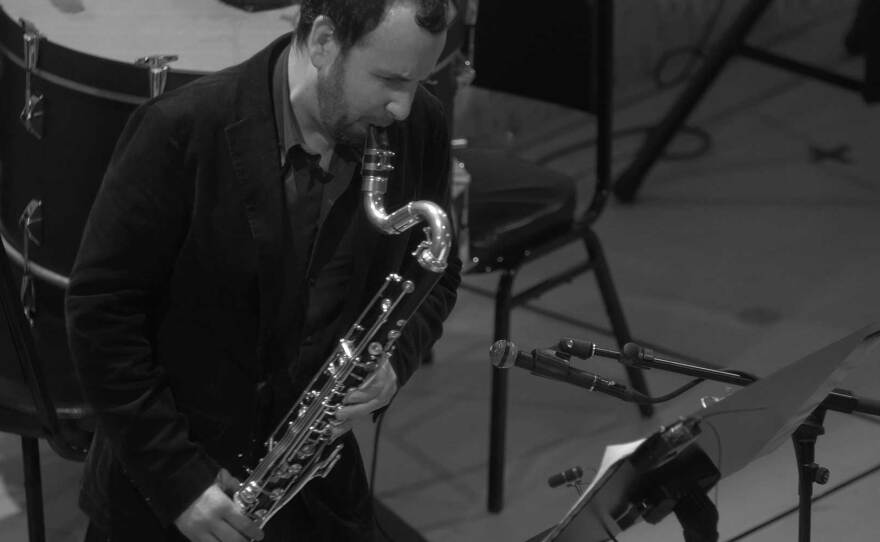Maybe there's an opening line of a joke here: A bass clarinet, a nonsense monster and a caterpillar walked into an art museum...
To bass clarinetist Joshua Rubin, it works. Rubin is part of the "Abstraction and Allegory," virtual concert — an Art of Elan and San Diego Museum of Art collaboration that releases Friday.
"A poem like Carroll's 'Jabberwocky' is a wonderful way to think about abstraction in art," he said. "I feel like abstraction in art is taking bits and pieces from what we might say is the objective reality and kind of applying them creatively to make new things. And since our brains love patterns, the new things are still familiar to us. You can accept them, in whatever state they're in, in whatever newness they're in."
The SDMA+ series pairs various performing arts with specific works in the museum's collection to help reframe (no pun intended) or add meaning across artistic disciplines. It also turns visual art into sort of a tune-in show — which is something audiences are craving during these pandemic times.
RELATED: Contemporary Sculpture Becomes Original Jazz At SDMA
Friday, Feb. 19 at 7 p.m. (Runtime: approx. 15 min) via YouTube.
Program:
- Unsuk Chin, "Advice from a Caterpillar (2007)," from Alice in Wonderland
- Andrea Isabel González, "Jabberwocky (2021)," World Premiere
- Performer: Joshua Rubin (bass clarinet)
In this performance, the locally based chamber group Art of Elan paired Rubin with an existing contemporary work by South Korea composer Unsuk Chin, "Advice from a Caterpillar," (that's right, that Lewis Carroll caterpillar), and with Mexico-based composer and interdisciplinary artist Andrea Isabel González to create a brand new work.
González's "Jabberwocky (2021)," will have its world premiere in the program. González jumped at the chance to create not only a new composition, but also to make a video. She is a contemporary composer but also works with electronic music and video forms too.
The composer, who spoke to KPBS from Guadalajara and lives in Querétaro, Mexico, said she loves Lewis Carroll and grew up watching the older movie adaptations, but only recently read the text version and connected with the poem.
"That moment, the poem was so deep in me. It was something shocking, to see that nonsense poem," González said. "Maybe, I think that my music is something that's searching for its own language. This 'Jabberwocky' piece is the result of that."
The poem begins, yes, with nonsense:
"’Twas brillig, and the slithy toves
Did gyre and gimble in the wabe:
All mimsy were the borogoves,
And the mome raths outgrabe."Lewis Carroll, from "Through the Looking-Glass, and What Alice Found There"
Carroll's "Jabberwocky" is a poem-within-a-story, encapsulated in the sequel to "Alice's Adventures in Wonderland," "Through the Looking-Glass, and What Alice Found There." Alice finds the verses in a book printed in mirror-writing, and the work has been played with by critics and artists alike ever since.
"Most of the nouns and the adjectives of this poem are completely invented, but the poem can still tell the tale of this mythical monster, and it's even more fantastic because of that invented language," said Rubin. "I think that's such a great metaphor for a lot of the 20th and 21st century art that has been made."

The Unsuk Chin piece centers on the scene in which Alice meets the caterpillar — there's absurdity in the questions the caterpillar asks, the concepts of changing size, and the way Alice twists the questions back upon the caterpillar. "It's a really wonderful and fascinating piece," said Rubin. "The scene is sung from the point of view of the caterpillar, me as the bass, I am the caterpillar, and the kind of hookah the caterpillar has is the bass clarinet," he said.
He also uses that sense of character in the "Jabberwocky" performance, translating some of the language twists and magic from the text into the notes and sounds he plays.
The bass clarinet's sound is as enchanting as it is versatile. It can play incredibly low notes, but also surprisingly high. The richness of sounds, like growls and gurgles, make for a whimsy to contrast its steadfastness. It can blend into traditional works as easily as it can stand out in pop music or experimental pieces.
It can seem mysterious, though Rubin said it's been a popular instrument among composers for a long time. In some ways, the instrument choice is perfect for Alice in Wonderland-inspired works: fantastical, broad-ranging and approachably abstract.

Art of Elan executive and artistic director Kate Hatmaker said they honed in on a particular section of the museum's "Masters of Photography: The Garner Collection," which includes work by Frank Eugene and Gregory Crewdson, described by the museum as "expressions of abstraction and allegory." This turn of phrase fed their concert theme and title.
"We thought it would make for an interesting jumping-off point in terms of exploring the fantastical and how it's portrayed in music by women composers today," Hatmaker said over email.
The performance, which premieres Friday, Feb. 19 at 7 p.m., will be viewable for free on the San Diego Museum of Art YouTube channel, and will be archived online afterwards.






